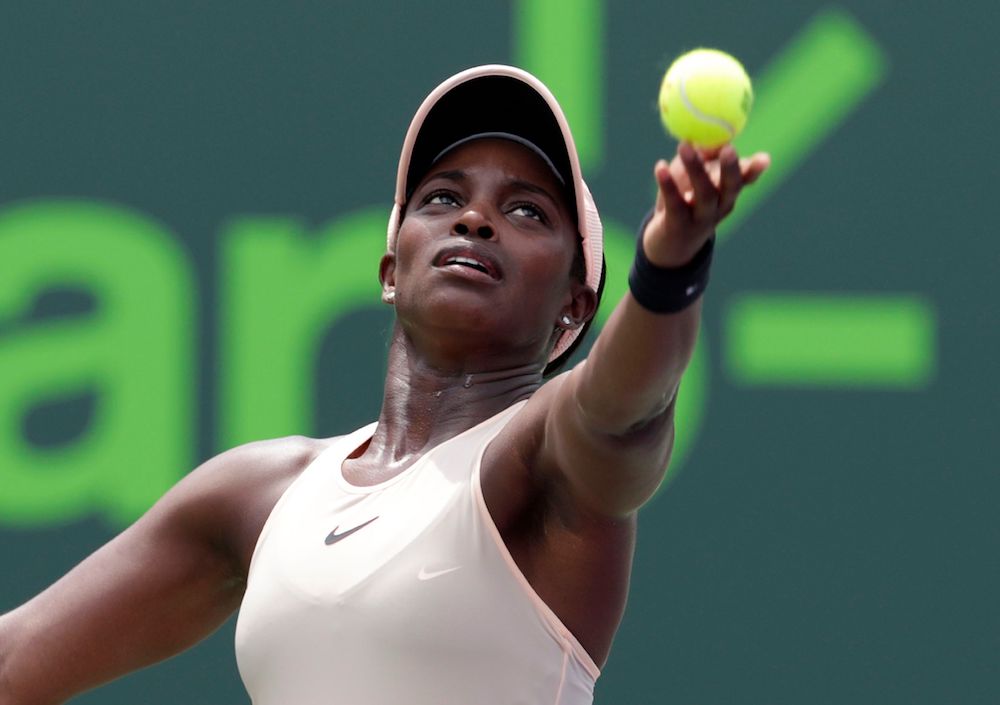Welcome to Tennis Elbow, the column that looks back on the week that was in the world of tennis. This week, Charles Blouin-Gascon recaps the first week of the 2019 BNP Paribas Open.
Will the real Sloane Stephens please stand up?
Oh we know, this opener is as cliché as it gets but there’s some truth behind it and we believe that it speaks to a greater, and broader, conclusion: that life on tour is really damn hard.
You know Stephens, right? Long ago announced as a possible force after her run to No. 5 in the juniors, Stephens turned pro already a decade ago in 2009 and is the current World No. 4 player with a career-high ranking of No. 3. She’s also the 2017 US Open winner, has six career WTA titles, and she also made the 2018 French Open final.
It is here that we’ll mention that if it feels like we’re just stating biographical details about Stephens, it’s a little bit by design. You see, we’re using this to show you how much success Stephens has enjoyed over the past two years, and how accomplished she’s become, and yet that she still lost in the first round this past week in Indian Wells, 6-3 and 6-0 against No. 109 Stefanie Voegele. She’s among the very best in the world, and on one of the biggest stages of the world, she can’t even win one match?
Yeah, can the real Sloane Stephens please stand up?
Mind you, diehard fans of the player have become accustomed of such highs and lows in the unfolding of her career. After a stunning run to the 2013 Australian Open semifinal, where she upset Serena Williams in the process, Stephens, well, didn’t really do much afterward. She won her first career title two full years later in Washington, DC, then mostly progressed until the 2016 Rio Olympics before shutting things down with a foot fracture.
Until then, things are fairly fine but they would get much, much worse before they got better. The American couldn’t come back to the WTA before Wimbledon in 2017 after an 11-month layoff; by August, she was ranked No. 957, which seems unspeakably low for anyone let alone someone of Stephens’s reputation and accomplishment.
From there, a mere weeks later, Stephens snagged a US Open title. Surely, this would be the break and result she needed, right? Wrong, as the newly crowned champion proceeded to lose her next eight matches immediately following her win at Flushing Meadows, a streak that lasted through the 2018 Australian Open. If you’re saying “what the fuck?” under your breath, you’re not alone.
We say all this to say that perhaps more than anyone else currently playing, Stephens is a good emblem for how ridiculously difficult life is as a tennis pro: one day you’re on top, but the next one you could find yourself down in the ditch—or, in the case of Stephens, in the Tennis Channel announcer’s booth.
We’re not revealing you any secrets by stating that tennis is a freaking ruthless and unforgiving sport and that perhaps we’ve lost our perspective on this recently.
In tennis, you stand alone on a court and hit a yellow ball over and over and over and over again over a net and into an opposing court, and if you do it well enough you win a point. And if you do it well enough for long enough, then you might win a game, a set and even a match. Once you’ve done that, you get to move on to another match against a new opponent and with the same yellow ball. Rinse repeat, until one day you’ve won a tournament because you’ve nagged six or seven match wins in a row at the same event. That’s when tennis tells you, “Congrats, you’re a champ now; now do it all again next week.”
We’ve grown accustomed to the fact that top players should perform exceedingly well every single time they step on the courts when that’s simply impossible.
It’s not either that this is restricted to women’s tennis either. There was a time when we ridiculed Tomas Berdych for never managing to get over the hump when, in fact, we should have been cheering him on for even making 11 of 19 Grand Slam quarterfinals from 2012 through the end of 2016. Just ask players like Alexander Zverev, Stefanos Tsitsipas, Milos Raonic or Nick Kyrgios how easy this all is.
It’s all so difficult, and yet Roger Federer, Rafael Nadal, Novak Djokovic and Serena Williams manage to (almost) always do it. We’re tipping our virtual hats off to them, but this shouldn’t be an indictment on the highs and lows of a player as accomplished as Sloane Stephens, who, we’re repeating it here just so it’s clear, is the current fourth best player in the world.
She’s the fourth best player in the world, and she can lose in the first round to no real surprise.
If this can happen to her, what chance do other players have?
Follow Charles Blouin-Gascon on Twitter @RealCBG


























